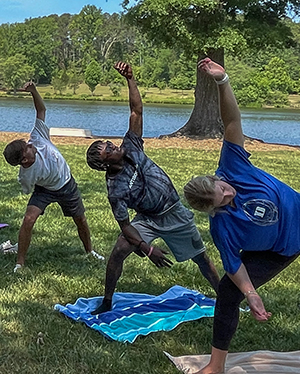MayX Snapshot: Modern minds examine an ancient discipline
This week, we’re highlighting courses from May Experience – a chance for students to explore topics beyond the typical academic year.
COURSE: Yoga in America
INSTRUCTOR: Diane Boyd, associate dean of faculty development and executive director of the Faculty Development Center
DESCRIPTION: Students explored the history of yoga and its popularization in American culture.
How could an ancient practice, with roots in Eastern philosophies that emphasize simplicity, transform into an industry marked by expensive props, clothing and lifestyle retreats?
To find out, Diane Boyd, associate dean of faculty development, executive director of the Faculty Development Center and certified yoga instructor, challenged her MayX students to look back to another millennium.
For centuries, yoga was seen as primarily a mental discipline, Boyd noted. “Yoga is the restriction of the fluctuations of mindstuff,” according to its foundational text, “The Yoga Sutras of Patanjali.” Scholars of the era outlined the ashtanga – the “eight limbs of yoga” – that culminate in a state of meditative consciousness called samadhi.

Students practice a yoga pose by the side of Furman Lake.
As yoga spread to the West at the turn of the 20th century – sometimes practiced by contortionists in sideshows – the discipline of the mind became overshadowed by the discipline of the body, said Boyd.
“Today, when you go to a yoga class, there’s usually savasana, or relaxation, at the end,” Boyd said. “Whereas in traditional yoga practice, that’s where you would actually be meditating intently. And the whole point of the physical practice is to release tensions and tire out the body somewhat so that the mind can settle into a more meditative state.”
The first two of the eight limbs of yoga, yamas and niyamas, “are all thought-based, all behavior and discipline,” said Boyd. “You don’t even get to asanas, or physical practice poses, until the third limb.”
Appropriately, minds got most of the workout in her MayX course, Yoga in America, including class discussions and weekly reflective writing assignments. One assignment asked students to take a deep dive into a seemingly mundane object: the yoga mat. “It is foundational to yoga practice,” Boyd asked, “but does it align with yoga values?”
Daily yoga practice usually centered around that day’s discussion topic, Boyd said. Beyond the dance studio in the Lay Physical Activities Center, the students also explored other contemplative venues, such as the edge of Furman Lake or inside the Thoreau Cabin after reading about the philosopher, for instance.
The students’ goals varied, but some were still seeking the same “reduction of fluctuations of the mindstuffs” that the ancient texts espoused, Boyd said.
“For many of them, it’s about reducing anxiety and trying to use this consistent practice as a way to reduce self-imposed ‘monkey mind’ – being very distractible and not able to focus,” she said. “Some of them wanted to increase strength and flexibility. And some wanted to not be so attached to particular relationships in their lives, or be able to make space for their own things they want to do, rather than just moving through a set of activities that’s been prescribed for them.”
And some students found a pursuit that can last a lifetime.
“There’s no age to yoga,” said Lia Gaw Ghie Paw ’23. “A woman who has been practicing came up to me and told me, ‘I am 65, and I have been doing this for 10 years,’ and she was killing it at the hot yoga practice.”